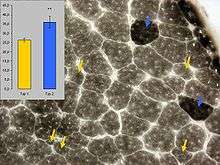Congenital fiber type disproportion
Congenital fiber type disproportion (CFTD) is an inherited form of myopathy with small type 1 muscle fibers that may occur in a number of neurological disorders.[1] It has a relatively good outcome and follows a stable course. [2] While the exact genetics is unclear there is an association with TPM3, ACTA1 and SEPN1 gene mutations.[3] It is a rare condition.[4]

History
The condition was named by M. H. Brooke in 1973.[1]
References
- Clarke NF, North KN (October 2003). "Congenital fiber type dispropsortion--30 years on". J. Neuropathol. Exp. Neurol. 62 (10): 977–89. doi:10.1093/jnen/62.10.977. PMID 14575234.
- Na SJ, Kim WK, Kim TS, Kang SW, Lee EY, Choi YC (August 2006). "Comparison of clinical characteristics between congenital fiber type disproportion myopathy and congenital myopathy with type 1 fiber predominance". Yonsei Med. J. 47 (4): 513–8. doi:10.3349/ymj.2006.47.4.513. PMC 2687732. PMID 16941741.
- Clarke NF, Kolski H, Dye DE, et al. (March 2008). "Mutations in TPM3 are a common cause of congenital fiber type disproportion". Ann. Neurol. 63 (3): 329–37. doi:10.1002/ana.21308. PMID 18300303.
- Sharma MC, Ralte AM, Atri SK, Gulati S, Kalra V, Sarkar C (June 2004). "Congenital fiber type disproportion: a rare type of congenital myopathy: a report of four cases". Neurol India. 52 (2): 254–6. PMID 15269486.
This article is issued from
Wikipedia.
The text is licensed under Creative
Commons - Attribution - Sharealike.
Additional terms may apply for the media files.